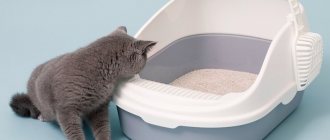What do cold ears say?
The coolness of areas of the body without fur has a well-founded explanation related to the physiological characteristics of the animal. Since heavily furred cats do not have sweat glands on their bodies, excess heat generated by the body is released through the hair-free skin. This is why a cat that has no health problems may have cold noses, ears, and paw pads. In this case, we are talking about a completely normal phenomenon that does not require intervention.
In addition, the ears may be cold if the pet is cold. In this case, he can cuddle up to the radiator, climb under the blanket, or look for other warm places in the house. If this happens constantly, then it is worth intervening - put clothes on your pet and provide it with a covered bed. This is especially true for representatives of breeds that naturally do not have a “fur coat”.
Cold and hot
The temperature of an animal's ears can depend on many factors and does not necessarily indicate that some negative processes are occurring inside the body. The reasons may be the following:
- the cat does not have enough warmth, that is, speaking in natural language, it is freezing, so it tries to lean its body against a person or some warm object in order to warm up;
- Cold ears in cats can also occur when the animal is pregnant and this is one of the manifestations of toxicosis, which also occurs in cats; in this sense, they are not too different from humans;
- Cold ears are also one of the signs of a disease that can even lead to the death of a pet.
© shutterstock
In any case, a cat's ears are an indicator of an internal state that you need to pay attention to. But remember that even when a cat has cold paws and ears, this is not necessarily a negative characteristic of the animal’s general condition.
The tips of the ears are cool according to the general physiology of these pets , since it is in these places that the smallest number of blood vessels are concentrated.
In addition, the ears are covered with sparse hair, so they become a natural zone for the release of internal heat.
Why do the tips of my ears get cold?
Again, you can turn to the anatomical features of the animal’s body. The ear has few blood vessels, and the auricle itself is just thin cartilage covered with thin, delicate skin. The closer the ear is to the sink, the more its skin thickens.
The absence of blood vessels means that these areas without blood circulation do not receive heat. That is why the very tips of the ears, if you touch them, remain cool. This is a natural state and there is no need to worry about it.
Condition of the nose in cats and kittens
The nose is also a kind of indicator of the condition of cats. Using it, you can determine the causes of diseases in the cat’s body, as well as recognize the main symptoms of the disease. If the owner knows the condition of his pet’s nose, what conclusions can he draw to urgently contact a veterinarian :
- if the nose is dry, this means that perhaps this is one of the manifestations of some disease of the pet, since in normal conditions the surface of the nose should be moist;
- but these signs are not the main ones when determining the disease in a cat at home, the main thing is that the paws and ears become warm, this is a reason to worry, especially if other signs of the disease appear;
- There is coldness inside the auricle, which is a sure sign that urgent treatment is necessary to preserve hearing, and subsequently life, since pus can cause infection.
As you can see, everything lies in the area of proper care for your pet’s paws and ears. If you care for the animal correctly, then the result will be the best.
© shutterstock
Overview of Possible Causes
It can take a very long time to independently look for the cause of the redness of a cat’s ears, and uncontrolled use of drugs can also harm the pet. This is especially true for adults, in whom, after the age of 10 years, the risk of tumors in the ear canal increases. There are many cases where a diagnosis made “by eye” resulted in long-term treatment for otitis media or ear mites, but in fact the reason lay in a formation that may be located deep inside the ear and cannot be seen without otoscopy. Based on this, we recommend that you familiarize yourself in advance with the possible causes of this symptom:
- If your cat's ears are red inside, then first of all it is necessary to exclude the possibility of an allergy. It can be triggered by poor diet, insect bites and contact with a potential allergen (less often). In terms of frequency of occurrence, food allergies, which are typical for decorative breeds, are in first place. Along with redness, discharge from the ears (in the form of brown or black mud), an unpleasant odor and severe itching often appear. In some cases, you can notice how the pet literally tears the ear area until it bleeds. Shaking the head more than once during the day can also be considered a characteristic sign. Flea dermatitis and ear mites, along with all the above symptoms, are also characterized by the appearance of flaking and black dandruff in the coat. The reaction can be triggered by just one flea. Getting her saliva on the skin is enough. Atopic dermatitis is considered an incurable but manageable disease. With a well-chosen treatment regimen, stable remission can be achieved. If an animal is allergic to flowering plants or fluff, seasonal exacerbations may occur. Treatment of all types of allergies begins with searching for and eliminating the potential allergen (treating for fleas and ticks, switching to hypoallergenic food, or removing plants from the house that may be poisonous to the pet). In difficult cases, a biochemical blood test may be necessary. You need to understand that most substances (dust, mold, hair from carpets, blankets or other animals) are almost impossible to eliminate from everyday life, so allergic cats will need lifelong maintenance therapy and antihistamines during periods of exacerbation.
- Otodectosis. A familiar problem to many cat owners who go outside for walks. The tick is transmitted through direct contact with an infected animal or through grooming items (collar, leash, clothing, comb, etc.). In the external environment, the parasite can survive up to 2 weeks. It always manifests itself acutely - red ears inside, brown discharge and peeling. At the same time, the pet regularly scratches the area of the temples and behind the ears, which is why large wounds can appear in these places. Because of this, otodectosis can be complicated by a bacterial infection. For diagnosis, you will need pieces of the epithelium of the ear canal and secretions, which are sent for microscopic examination. Under a microscope you can see the otodex mite, which is the cause of all the troubles. The universal preparations Stronghold (in the form of drops on the withers) and Frontline (instilled into the ear canal) are used as treatment. In most cases, two treatments 3 weeks apart are enough to get rid of the problem. Be sure to treat all animals that live with the infected cat, as even after complete recovery, a relapse is possible.
- Otitis. A common disease in cats of all breeds and all ages. In most cases it acts as a complication of the underlying pathology. The appearance of otitis media can be caused by an allergy, a formation in the ear canal, or a bacterial or fungal infection. Ear mites and fleas are the most common causes of otitis externa. This can cause red ears inside and foul-smelling discharge. To determine the cause of otitis, you will need discharge and deep pinches, which are sent for cytological and microscopic examination. In difficult cases, an otoscopy may be necessary to determine the likelihood of damage to the eardrum. To clean the ears, use special lotions (Otifri, Hartz), which are poured inside. Immediately after this, massage the area behind the ears and allow the animal to shake out the contents. When cleaning, it is not recommended to use sticks or other objects of a similar nature, which can create an ear plug.
Diagnosis of ear diseases in cats
Each disease has its own diagnostic method. The owner can determine whether a pet has ticks on his own. To do this, take a cotton swab and run it along the inside of the ear. Then transfer the scraping to a black cloth and examine the contents under a magnifying glass. As a rule, white parasites will be noticeable during such an examination.
In other cases, the diagnosis is carried out by a doctor. An accurate diagnosis is made based on a visual examination of the animal (wounds, scratches, peeling in the ears), smear, x-ray, ultrasound, bacterial culture. It is not always possible to use the latter method due to the lack of equipment in many clinics, but it is the most accurate.
Treatment depends on the specific disease and can be medicinal and surgical (in the presence of tumors).
When should you consult a veterinarian?
The owner can determine some causes of severe itching of the ears on his own. For example, you can see a foreign object stuck in the ear, a hematoma, or a bee sting. Diagnosis of otitis media, ear scabies, and allergies is possible only in a veterinary clinic. To clarify the diagnosis and the degree of development of the disease, the specialist conducts laboratory tests of ear secretions, blood, and analyzes X-ray and ultrasound data. Based on the examination results, the optimal treatment regimen is selected.
Symptomatic treatment
Physiological tremor does not require treatment.
To understand that a cat is shaking its head because it is in pain, it is important to observe it. The following signs should alert you:
- the animal not only shakes its head, but also actively itches (to the point of wounds and abrasions);
- pus or ichor flows from the ears;
- the cat does not lay its head on a certain side;
- the animal's appetite decreases or completely disappears;
- there is a shaky gait, movements are not coordinated;
- the cat meows loudly and pitifully or, on the contrary, becomes lethargic and tries to hide from prying eyes.
In case of pathological jerking of the head, the diagnosis must be made by a doctor. To do this, he will examine the cat's ears and take blood tests. If no external signs of pathology are found, the veterinarian will perform an ultrasound or computed tomography. After making the correct diagnosis, the specialist will prescribe the appropriate treatment:
- For the treatment of otodectosis, antiparasitic ear drops may be sufficient; for the treatment of otitis, antibiotics will have to be used.
- It is also best to entrust the removal of foreign bodies from the ear to a veterinarian. After the procedure, the specialist will treat the ear with antibiotics and prescribe drops that will help avoid infection.
- Antifungal therapy involves treatment with chlorhexedine (rinsing the ears with a solution) and treating the ears with Otibiovin drops. Veterinarians also prescribe internal administration of Ketokenozol. But it must be given to your pet strictly in the dosage recommended by the veterinarian.
- Dermatitis is treated with hydrogen peroxide and treatment with ointments that have astringent properties, for example, 2 percent silver nitrate. Dropping a few drops of novocaine into the ears will help relieve itching.
- If neoplasms occur, the issue of surgery is decided. Most often, the ear and hearing can be preserved when growths and tumors are removed.
- Neurological disorders and failure of one or another organ require specific treatment, which can only be offered by an experienced veterinarian.
- Multiple organ diseases and liver failure require treatment of the underlying disease. When recovery occurs, the tremor will go away.
When to see a doctor
For any cat, scratching its ears is a normal process, which is a hygienic procedure that helps the animal get rid of dirt and foreign bodies. But when it becomes permanent, and the pet experiences great discomfort and anxiety, it is necessary to show it to a doctor. Only by identifying the reasons for this behavior can effective treatment methods be selected.
If a cat has otitis media, measures taken to get rid of ear mites can lead to serious consequences, including complete hearing loss. A visit to the clinic should not be postponed if:
- Ear scratching causes anxiety, causing the cat to shake its head in irritation.
- The animal becomes nervous.
- The cat scratches its ears vigorously more than 10 times a day.
- Small wounds appeared on the surface of the ears.
Detection of one or more of the listed symptoms is a serious reason to visit a doctor.
How to warm a cat's paws
As written above, your task is to determine the base body temperature and if it is normal, but the cat’s paws are still cold, you need to try to warm them. First, evaluate how warm it is in the home and how the pet behaves:
- Does the cat walk on the floor or prefer to move on the top?
The higher you go, the warmer the air.
Perhaps your pet is freezing?
- Perhaps the cat was moulting and the weather suddenly got colder - our pets are warmed by the undercoat, not the guard hair.
- Does your pet climb into your bed to sleep? If so, she's looking
Additional heat sources
.
The best option is Insulated with a thick backing
. Recently, recommendations have appeared on forums about insulating houses with heat-insulating fabric. Yes, it doesn’t look very attractive, but you can’t lure cats out of their warm nests.
What to do?
If you suspect your cat is unwell, first of all, you need to measure its temperature. It should be kept in mind that the normal temperature for an adult cat is 38-39 degrees. In small kittens, the normal temperature can be up to 40 degrees. And, for example, in hairless cats it is even higher – 41.5.
What to do if hot ears are still a sign of disease? The answer is clear: immediately contact a specialist who will examine the cat and prescribe appropriate treatment.
Thus, we can say with confidence that a cat’s hot ears are not yet a reason to sound the alarm. High ear temperature in itself is not a sign of disease. If your pet not only has hot ears, but also a dry and hot nose, and behavior and appetite have also changed, then in this case we can talk about the onset of the disease.
How to help an animal
Hot ears in a cat are not a pathology in themselves, which means that trying to cool only one ear (for example, by applying ice compresses) is pointless. The first thing to do is to examine the animal for other symptoms. If they are not there, then you should leave the cat alone for 20–30 minutes and feel the ears again - in a healthy animal, by this time the blood flow will normalize and the skin will no longer be hot.
When fiery ears are still a symptom of some kind of disease, it is necessary to begin treatment. It depends on the diagnosis:
- If the ears are burning due to severe stress, then first you need to create the most comfortable conditions for the cat and remove all irritants. There is no need to forcefully try to pick up the animal or stroke it (this will only increase the stress). It is better to provide maximum peace, but leave water and tasty food nearby. If after a couple of days the cat’s mental well-being is not restored, veterinarians will prescribe sedatives: Clomipramine;
- Cat Baiyun;
Kot Bayun is a sedative medicine based on natural herbal ingredients - Fitex;
- Vetspokoin;
- Anti-stress;
- Phospasim;
- Vetranquil.
- Surolan;
Amitrazine is a veterinary drug that is used for cats in the treatment of pathologies caused by sarcoptic mites
During treatment of otitis media, ear mite infection, and after surgery, the cat must be wearing a medical collar that prevents the animal from scratching the sore ear.
If the cat has a fever
If the ears are hot, you need to make sure that the animal’s body temperature is normal. If you don’t have a thermometer, just feel the animal’s nose - it should be cold and wet when awake. If you have a temperature measuring tool at home, you should use it. For an adult cat, readings below 37.5˚C and above 40˚C are a serious reason to immediately contact a veterinarian. Fever occurs when:
- infectious diseases;
- poisoning;
- tumors;
- allergies.











